by Siddharth Singh Bhaisora
Published On Nov. 30, 2023
Why have some of the best quant funds earned nearly 40-60% CAGR returns for nearly 20 to 30 years? That is what we will discuss today. We will look at Renaissance & Citadel - the top performing quant funds in the world.
What is it that sets these 2 apart?
What are the challenges faced by the top quant funds in their path to success and glory?
What can you as an investor takeaway from it?
There is limited information about these quant funds that we are looking at. So we are attempting to piece together a puzzle based on publicly available information. But, before we get into the top performing Quant Funds, let’s understand what quant funds are first.
Quantitative funds, commonly known as quant funds, utilize computer algorithms and quantitative methods to identify and trade stocks. They apply a systematic investing approach, minimizing human emotional influence and enhancing portfolio diversification. In volatile markets, quant funds can offer advantages with their low correlation to other asset classes, strategic flexibility, and potential superior performance. However, they come with risks such as market, liquidity, model, data, human error, and systematic risks.
These funds employ complex mathematical and statistical models, along with algorithmic strategies, for trading opportunity identification and execution. They heavily depend on quantitative analysis for investment decisions, thus eliminating subjective human judgment and emotional factors. These funds analyze vast amounts of data to capitalize on market inefficiencies and trends.
What does a quant team look like typically? Quant teams are typically composed of mathematicians, statisticians, and computer scientists, differing from traditional traders in skillset and approach.
So let’s get into it. Let’s look at the best quant funds that solved the market.
Want to learn more about quantitative investing, read our article on What is Quantitative Trading? and Best Quantitative Investment Strategies 2023 .
Jim Simons' story is indeed remarkable. Starting a hedge fund at 40 after leaving a career in academia, he went on to become one of the most successful hedge fund managers globally and one of the richest people in the world.
Born in Newton, Massachusetts, Simons demonstrated his mathematical prowess early on. He achieved significant academic milestone by earning his Ph.D. in mathematics from the University of California, Berkeley, in 1961. His academic career, which included prestigious positions at MIT, Harvard, and Stony Brook University - he made notable contributions to geometry and topology.
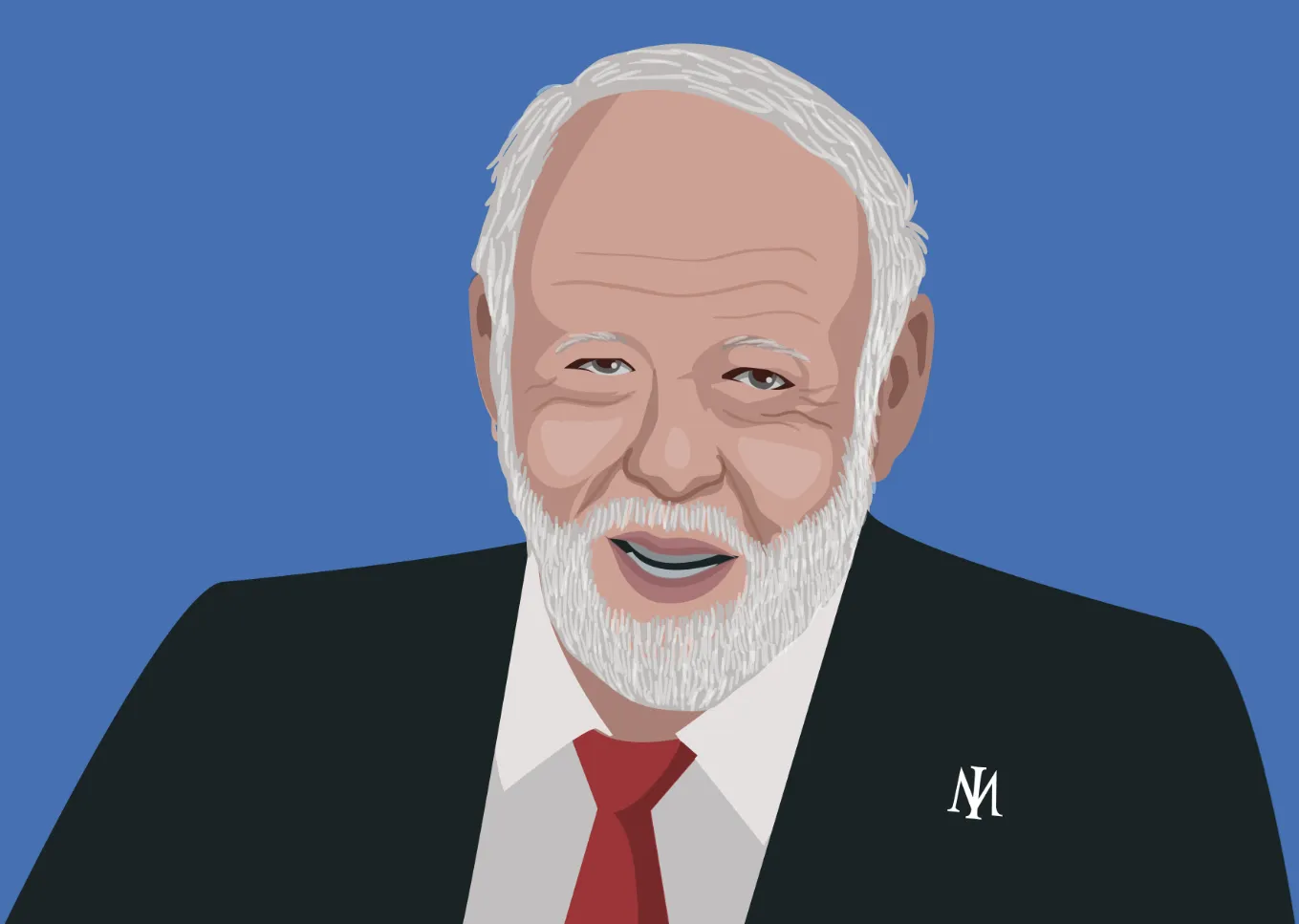
In 1978, Simons founded Renaissance Technologies in New York. Here, he revolutionized the industry by leveraging sophisticated mathematical models and algorithms for investment decisions. This approach, radically different from traditional investment strategies, involved analyzing vast quantities of historical data from diverse sources. Renaissance Technologies, especially its Medallion Fund, quickly became renowned for its exceptional financial performance, setting new standards in the hedge fund industry.
The Medallion Fund, the flagship of Renaissance Technologies, stands out for its exceptional performance. It has been known for its secretive and highly effective automated strategies - a testament to Simons' genius. It's noteworthy for being exclusive to employees, which is quite unusual in the hedge fund industry. This exclusivity has possibly contributed to its sustained success, as it aligns the interests of the fund managers directly with the performance of the fund. By employing rigorous mathematical and statistical models, the fund consistently delivered outstanding returns, outperforming traditional investment methods and establishing itself as one of the most successful quant funds in history.
Performance numbers for the Medallion Fund are staggering. With an average annual return of 66.1% before fees since 1988, and 39.1% after substantial management and performance fees, the fund's success is unparalleled. A $1,000 investment in 1988 into Renaissance’s Medallion Fund would have been over $23 million by 2018 - an extraordinary compounding power of these returns. Here’s a detailed breakdown of annual returns, fees, and the size of the fund from 1988 to 2018 showing a consistent pattern of high performance. This consistency is rare in the hedge fund world, where many funds struggle to maintain their edge as they grow in size and their strategies become less effective or revert to mean returns.
Year | Net Returns | Management Fee | Performance Fee | Jim Simons' CAGRBefore Fees | Size of Fund | Medallion Trading Profits |
1988 | 9.00% | 5% | 20% | 16.30% | $20 million | $3 million |
1989 | -4.00% | 5% | 20% | 1.00% | $20 million | $0 |
1990 | 55.00% | 5% | 20% | 77.80% | $30 million | $23 million |
1991 | 39.40% | 5% | 20% | 54.30% | $42 million | $23 million |
1992 | 33.60% | 5% | 20% | 47.00% | $74 million | $35 million |
1993 | 39.10% | 5% | 20% | 53.90% | $122 million | $66 million |
1994 | 70.70% | 5% | 20% | 93.40% | $276 million | $258 million |
1995 | 38.30% | 5% | 20% | 52.90% | $462 million | $244 million |
1996 | 31.50% | 5% | 20% | 44.40% | $637 million | $283 million |
1997 | 21.20% | 5% | 20% | 31.50% | $829 million | $261 million |
1998 | 41.70% | 5% | 20% | 57.10% | $1.1 billion | $628 million |
1999 | 24.50% | 5% | 20% | 35.60% | $1.54 billion | $549 million |
2000 | 98.50% | 5% | 20% | 128.10% | $1.9 billion | $2434 million |
2001 | 33.00% | 5% | 36% | 56.60% | $3.8 billion | $2149 million |
2002 | 25.80% | 5% | 44% | 51.10% | $5.24 billion | $2.676 billion |
2003 | 21.90% | 5% | 44% | 44.10% | $5.09 billion | $2.245 billion |
2004 | 24.90% | 5% | 44% | 49.50% | $5.2 billion | $2.572 billion |
2004 | 24.90% | 5% | 44% | 49.50% | $5.2 billion | $2.572 billion |
2005 | 29.50% | 5% | 44% | 57.70% | $5.2 billion | $2.999 billion |
2006 | 44.30% | 5% | 44% | 84.10% | $5.2 billion | $4.374 billion |
2007 | 73.70% | 5% | 44% | 136.60% | $5.2 billion | $7.104 billion |
2008 | 82.40% | 5% | 44% | 152.10% | $5.2 billion | $7.911 billion |
2009 | 39.00% | 5% | 44% | 74.60% | $5.2 billion | $3.881 billion |
2010 | 29.40% | 5% | 44% | 57.50% | $10 billion | $5.75 billion |
2011 | 37.00% | 5% | 44% | 71.10% | $10 billion | $7.107 billion |
2012 | 29.00% | 5% | 44% | 56.80% | $10 billion | $5.679 billion |
2013 | 46.90% | 5% | 44% | 88.80% | $10 billion | $8.875 billion |
2014 | 39.20% | 5% | 44% | 75.00% | $9.5 billion | $7.125 billion |
2015 | 36.00% | 5% | 44% | 69.30% | $9.5 billion | $6.582 billion |
2016 | 35.60% | 5% | 44% | 68.60% | $9.5 billion | $6.514 billion |
2017 | 45.00% | 5% | 44% | 85.40% | $10 billion | $8.536 billion |
2018 | 40.00% | 5% | 44% | 76.40% | $10 billion | $7.643 billion |
Jim Simons' CAGR is often cited as one of the highest in the investment world, setting a benchmark for hedge fund performance globally. The secret behind Jim Simons' impressive CAGR lies in his pioneering use of mathematical models and algorithms to predict market movements, a strategy that has consistently outperformed traditional investment approaches. Medallion's success over time is often attributed to their sophisticated trading algorithms and the use of advanced mathematics and data analysis, far removed from traditional investment strategies.
Investors and analysts frequently study Jim Simons' CAGR to understand the potential of quantitative finance and the impact of data-driven decision-making in achieving superior returns. This focus on quantitative methods, combined with a disciplined approach and a strong emphasis on research, has allowed Medallion to maintain its edge in various market conditions. Jim Simons' CAGR continues to inspire and influence a new generation of quants and investors, highlighting the transformative power of technology and innovation in the financial markets.
So what sets Renaissance apart? And how didJim Simons' CAGR become so large and consistent across decades?
Renaissance Technologies' position as a leading quant fund can be attributed to several key factors:
Renaissance has over 30 years of experience in analyzing Big Data to discern market patterns. They started with simpler markets like commodities and progressively advanced to stocks and complex derivatives. This extensive experience in building and refining their data pipeline gives them a significant edge.
Renaissance was among the pioneers in applying complex mathematical models to financial markets. This early start allowed them to develop and perfect their methodologies before others entered the field.
While other companies, like Google, have the capability to manage data effectively, they haven't applied these skills in the hedge fund domain as Renaissance has. The investment world's complexity means that mastery in one area, like data management, is just a part of the success equation that Renaissance has cracked.
Renaissance’s culture is deeply rooted in academic principles. Employees, often with strong backgrounds in mathematics, physics, and computer science, approach financial markets with intellectual rigor and proven research methodologies. This academic mindset fosters a continuous pursuit of knowledge and refinement of their strategies.
Jim Simons, a once-in-a-generation talent, successfully combined his academic excellence with strong managerial skills. His leadership was crucial in assembling and guiding a team of exceptional individuals, turning Renaissance into a highly efficient money-printing machine.
The Medallion Fund, Renaissance's best-performing fund, is exclusively available to its employees. This exclusivity aligns employee interests directly with the fund's performance. By keeping the fund closed to outside investors, Renaissance ensures that its strategies remain effective and are not diluted by excessive capital inflows, and its proprietary strategies continue to remain exclusive. An inherently great virtuous cycle that the Medallion Fund has managed to capitalize on.
Want to learn more about quantitative investing, read our article on What is Quantitative Trading? and Best Quantitative Investment Strategies 2024.
Let’s look at another quant fund, Ken Griffin’s Citadel, and see what exactly they did to earn high returns using their quantitative analysis.
Ken Griffin's Citadel is notable for its unique approaches to trading & using quantitative investment strategies . In 2018, Citadel hired a team of scientists and analysts to produce more accurate weather forecasts than most meteorological offices. A particularly strange yet very strategic move, for a hedge fund that relies on quantitative data for trading in various markets. They typically focus on using quantitative data to make trades in stocks, bonds and currencies. Citadel was looking at how weather could impact prices of assets, especially in the commodities sector. A $100,000 investment in 1990 into Citadel’s flagship Wellington Fund would have been over $19 million by 2021 - an extraordinary compounding power of these returns.
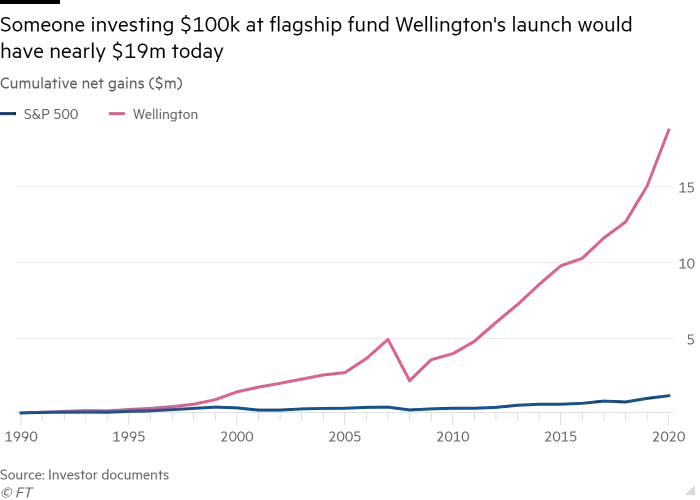
Using this unique skill set and thought-process, Citadel built a commodities business with $54bn-in-assets for both futures and physical trading. Their primary focus was on the gas, energy and power sector. In 2022, Citadel made a record $16 billion, surpassing Bridgewater Associates as the most successful hedge fund of all time. They even beat John Paulson’s $15.6 billion return earned in 2007 - which was well known as the “greatest trade ever” at the time. Here’s a look at how Citadel has performed since inception against the wider hedge fund industry. The shaded parts identify the periods when Citadel had underperformed the hedge fund industry.
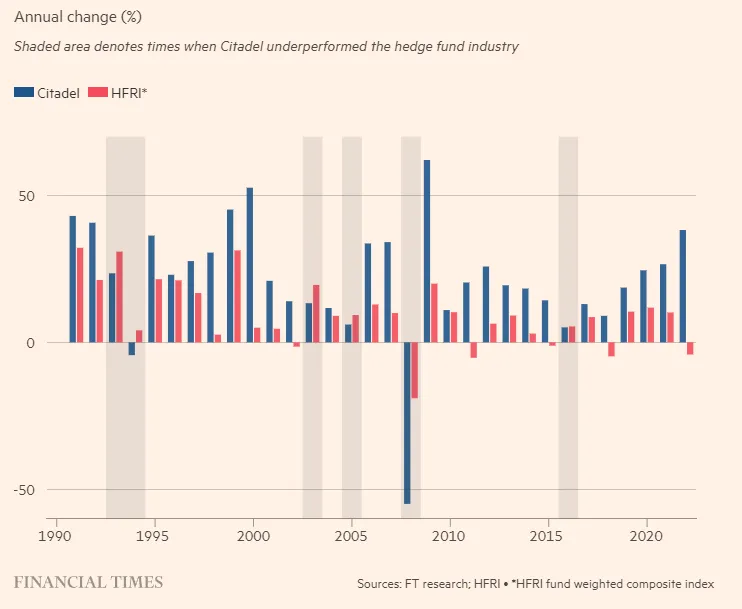
In hindsight, the Ukraine & Russia war, volatility in oil prices, the middle-east tensions as a result of the Israel-Hamas war , US & European energy issues - has all helped pay off on their big commodity bet. The commodity play produced returns of $8 billion last year - which is approximately 50% of Citadel’s overall profits for 2022.
And the funny thing is that Citadel started working on its commodities book, data & pipeline at a time when other hedge funds had scaled down their commodities play or were holding low single digits of these assets in their commodities book.
Citadel's success in capitalizing on the gas and energy sector can be attributed to a comprehensive approach that combines in-depth supply analysis with advanced demand forecasting from some of the smartest minds in the quant world.
Citadel's large teams of researchers meticulously map and analyze the supply side of the gas market.
Existence of numerous gas hubs across the U.S. and other regions provides a variety of pricing points that can be exploited for trading opportunities.
Ability to comprehend and quickly anticipate changes in supply side factors—whether due to geopolitical events, changes in production levels, or other factors—allows Citadel to position trades & bets in the market advantageously.
Demand forecasting, on the other hand, is notably more complex, primarily because it is heavily influenced by weather patterns, consumption changes, impact of ocean, moon etc on weather conditions etc. There are a lot of data points and it can be difficult to manage & understand what is happening
Energy usage spikes during extreme temperatures—hot summers increase the demand for air conditioning, while cold winters raise heating needs.
Citadel's edge in this aspect comes from its formidable weather team, which as we discussed earlier isn’t a common feature among hedge funds.
This team uses supercomputers to generate accurate forecasts and includes experts in specific meteorological phenomena like thunderstorms and tropical cyclones.

Citadel traders are provided with information from this dedicated weather team, which is capable of running sophisticated models to predict weather up to two months in advance.
The weather forecasting team was also working on sub-seasonal forecasts. Basically, beyond just predicting and forecasting how the weather would look like tomorrow, day after or this week - the team was looking at how to predict weather up to 2 months ahead.
These sub-seasonal forecasts are particularly challenging to predict, but they can be extremely valuable. Accurate long-term forecasts can provide insights into future energy demand trends, allowing Citadel to make informed trading decisions before these changes are reflected in market prices.
A combination of smart hiring choices by the management team at Citadel to prop up its commodity book that helped develop its rigorous supply side analysis and cutting-edge demand forecasting, particularly in the realm of weather prediction, has given Citadel a distinct competitive advantage. The firm's capacity to integrate and analyze complex data sets has played a significant role in achieving a remarkable 38.2% performance in the last year. This performance has contributed to an impressive annualized return of 19.7% since the firm's inception in 1990.
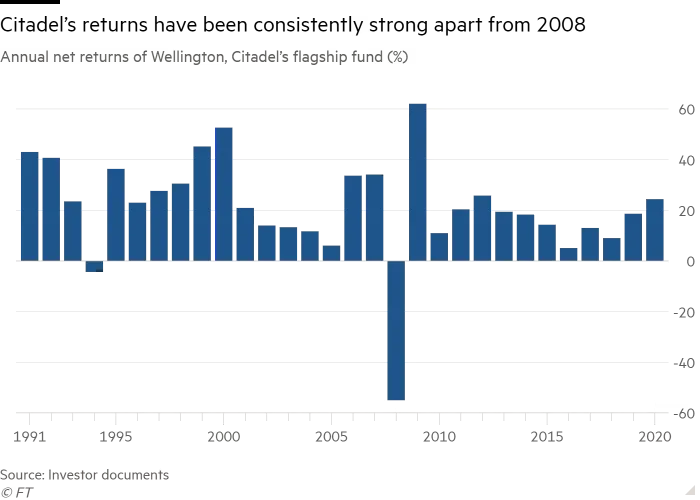
Citadel's success can be attributed to a multifaceted approach that includes technological innovation, data analysis, a talented workforce, and proactive risk management :
Citadel invests heavily in technology and data analysis, utilizing advanced algorithms and computer models to analyze market data. This enables the firm to identify and act upon trading opportunities quickly and efficiently.
Citadel's approach goes beyond generic data analysis or simply consuming lots of data points; they employ "fundamental checking points" to gauge the impact of global events and strategic decisions in the energy sector.
For example, prior to the conflict between Ukraine and Russia, Citadel had already considered the implications of a potential delay to the Nord Stream 2 gas pipeline, positioning themselves advantageously when the conflict seemed imminent.
Their granular tracking of supply and demand for commodities allows them to anticipate market shifts and inflation trends, which was instrumental during the volatile periods of market unrest.
A lot of this scenario analysis & big data predictions helped Citadel model inflation scenarios for Europe, UK & US. Which then helped them understand how commodity markets would play out along with price changes for other asset classes & markets as well.
Instead of simply growing its war chest & increasing its AUM, Citadel is investing in emerging areas like machine learning and corporate bond trading. This allows the firm to enhance its predictive capabilities and expand the productive capacity of its strategies over time without hurting its return generation potential.
Similar to Jim Simons’ Renaissance Technologies, Citadel employs highly skilled, highly talented & highly paid employees.
Nearly 20% of its investors are Citadel employees which ensures their interests are aligned with the firm's success. There is very little principal-agent problem as its employees are also investors in its funds. This not only incentivizes top performance but also helps retain talent which is essential for maintaining the sophisticated systems Citadel relies on.
Citadel operates under a multi-manager model, where individual teams of traders and portfolio managers work relatively autonomously. Costs such as salaries, bonuses, and technology investments are passed directly to investors instead of a traditional management fee.
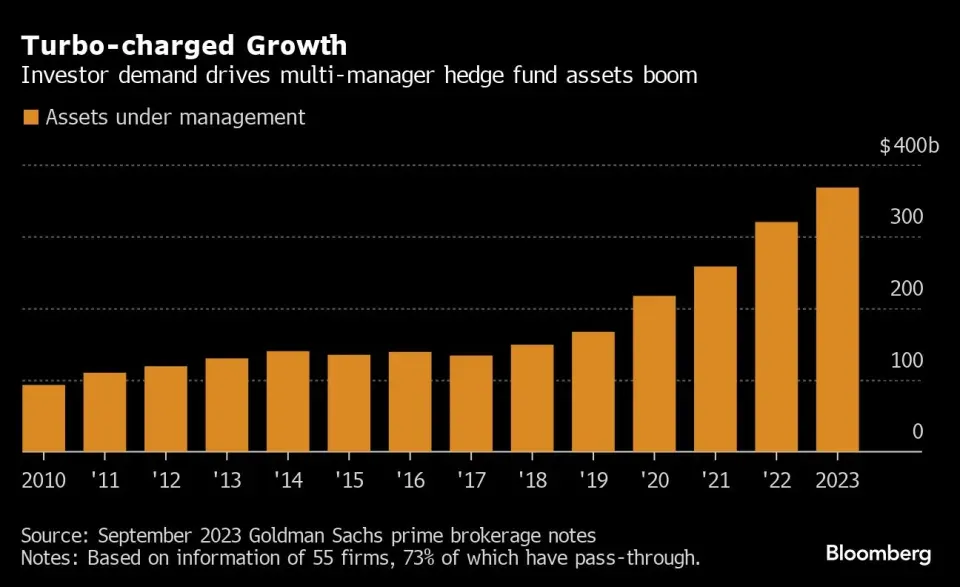
Citadel's fee model, which passes costs onto investors, may deter some due to its higher costs compared to the traditional "2 and 20" structure. However, for many, the long-term returns justify the costs. Citadel's model has been so successful that it has a waiting list of clients and it's being emulated by several hedge funds in Asia, where there is a talent war and a need to attract top professionals.
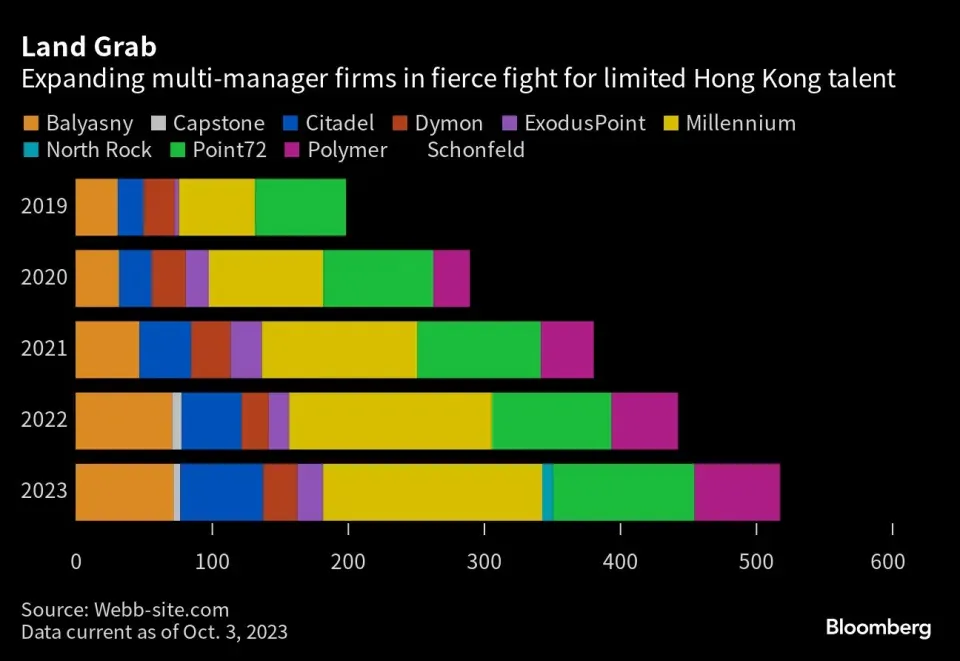
Out of the $28bn they earned, $12bn was paid in fees to Citadel. This significant portion of earnings paid in fees underscores the firm's commitment to attracting and retaining the best talent in the industry.
Even in 2022, when the S&P 500 lost 1/5th of its value & saw significant losses, Citadel's equity fund increased 21%. If you recall, global equity markets had a rough year in 2022. In volatile markets, Citadel's approach to risk management has proven to be a cornerstone of their success.
Rather than making sweeping market predictions or bets on economic policies, Citadel's equity portfolio managers focused on neutralizing market-wide risks.
This approach allowed individual investments to stand on their own merit without being overshadowed by broader market movements.
Citadel's risk factor models are constantly updated and reviewed against empirical data to ensure they accurately predict and mitigate risks.
Managing risk in Citadel’s mind is about what the firm does “before the event occurs” and not just what happens after an event occurs. This is a very forward-looking approach where they are trying to anticipate market changes & hedge their positions accordingly.
Renaissance Technologies and Citadel share several common success factors:
Both heavily rely on advanced technology and data analysis, using sophisticated algorithms and models for trading decisions.
Their unique company cultures prioritize intellectual rigor and innovation, attracting top-tier talent from diverse fields.
These firms continuously adapt and evolve their strategies to stay ahead in the dynamic financial markets.
Effective risk management techniques are integral to their operations, allowing them to navigate market volatility successfully.
Criticisms involve concerns about their market impact, such as potential destabilization due to high-frequency trading, and ethical considerations related to their secretive and exclusive operational nature.
Competitive edge: How do you maintain your competitive edge in an increasingly competitive and evolving market and ensuring their complex strategies remain effective.
Systemic Risk: They have large scale of operations and significant market influence. Their trading activities, particularly during turbulent market conditions, could potentially contribute to market instability.
Heavy Technology Dependence: Exposed to risks like system failures, cyberattacks, and technological obsolescence. Staying ahead technologically requires continuous and substantial investment.
Copycat Strategies: As their strategies become more known, there's a risk of other market participants adopting similar tactics, potentially eroding their competitive edge.
Ethical and Social Considerations: Questions arise about the broader impact of their trading activities on the markets and economy, including impacts on market fairness and accessibility for average investors. For instance Citadel’s play for oil & gas companies when the world is moving towards greener energy sources.
While difficult to replicate for individual investors, there are a few lessons we can take from these funds:
Quantitative Analysis is unbiased: can help in making more informed and less emotion-driven investment decisions.
Learning from Data driven approach: The success of these funds highlights the importance of using historical and real-time data for making investment decisions.
Investing in continuous learning for yourself
Innovative strategies: With an abundance of data at our fingertips, what unique and innovative investing themes and strategies can you find? Does a trending topic impact a stock’s price? Can you look at airline traffic to understand how delivery stocks will perform. The world is at your feet.
And finally, Limitations: Individual investors will find it difficult to replicate these complex quant strategies and finding funds like Wright Research that can create these quant strategies for you could be a great way to ensure you are following a data driven, unbiased approach to investing.
Read the full article on Wright Research, Best Quant Funds That Beat The Stock Market.
Other interesting articles to explore Complete guide to Momentum Investing & the Wright Momentum Portfolio & Buying Stocks in November & December? Evidence of Seasonal Patterns in Global & India.
As we look at Citadel & Renaissance, we should also look at how our home grown flagship momentum portfolio has done for its investors since inception 4 years ago. Yes, Wright Momentum has completed 4 years - and it has been a pleasure to watch it grow from strength to strength for all our investors. At Wright Research , we embody the same ethos of unbiased data-driven decision-making, harnessing advanced analytics, AI models and algorithmic precision to navigate the complex stock market terrain, as Renaissance & Citadel have done.
In just 4 years of a relatively volatile and tricky period for Indian stock markets, Wright Momentum has held strongly as a momentum factor portfolio.
We have focused on capturing growth through a systematic and disciplined approach to momentum investing. The fund's impressive track record is highlighted by its significant outperformance in comparison to traditional multicap funds over various time frames, with significant annualized returns since inception that have beaten the benchmark.
Wright Momentum's strategy is centered around identifying high-potential, high quality with strong momentum trends. Historically we had held a selection of stocks like TATAELXSI and TATAMOTORS, which have yielded absolute returns upwards of 300% and 197% respectively from 2020 to 2023 as you can see in the image below:
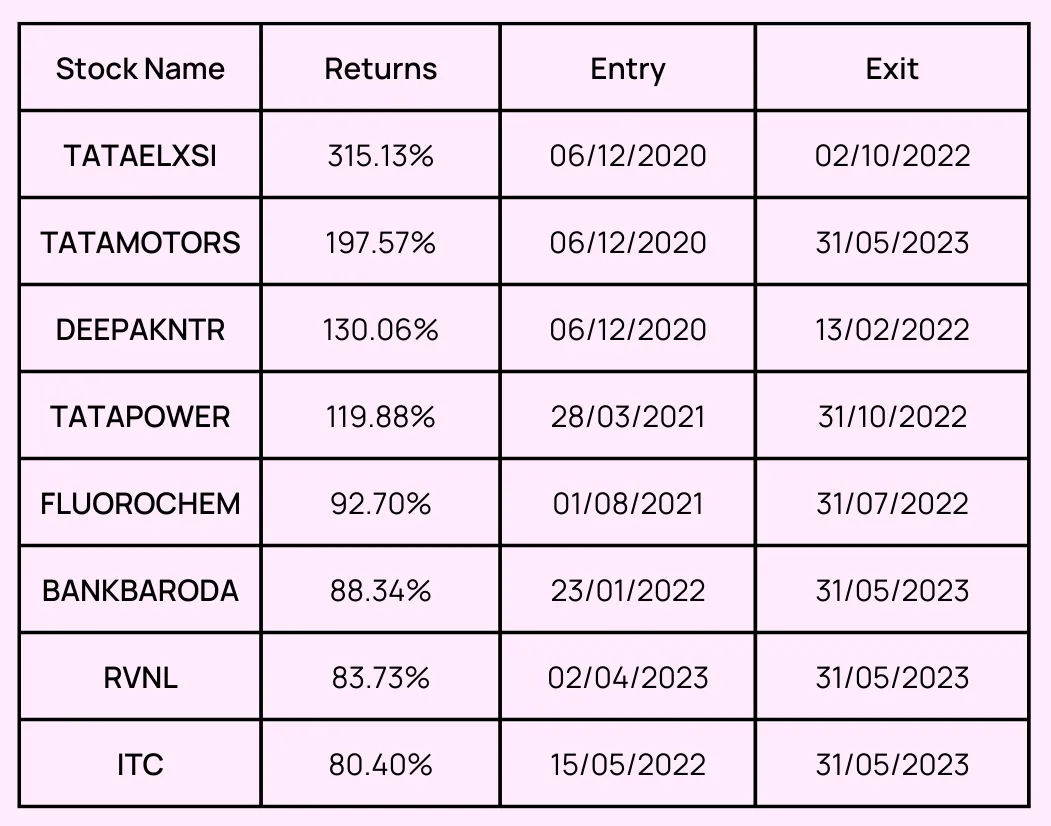
This meticulous approach to stock selection and timing, coupled with a monthly rebalancing frequency to capture market dynamics, has resulted in a portfolio that would grown a 1 Lac investment as follows:
Are you curious about the strategies behind some of the most successful quant funds in the market? What actually made these Quant Funds successful? And are there investing lesson that you can replicate? ⭐
In our latest video Sonam Srivastava & Siddharth Bhaisora discuss how Jim Simons' Renaissance & Ken Griffin's Citadel have managed to earn impressive returns 40-60% annual returns over 10, 20, 30 years and more. What differentiates them from other quant funds and investment managers?
Watch the full video on YouTube! 👇
Join our Telegram Channel to get daily morning market updates. Subscribe to our Youtube Channel to learn about all things investing, understand sector performance, get key insights into new topics like concentrated portfolio, quantitative investing and more!
Discover investment portfolios that are designed for maximum returns at low risk.
Learn how we choose the right asset mix for your risk profile across all market conditions.
Get weekly market insights and facts right in your inbox
Get full access by signing up to explore all our tools, portfolios & even start investing right after sign-up.
Oops your are not registered ! let's get started.
Please read these important guidelines
It depicts the actual and verifiable returns generated by the portfolios of SEBI registered entities. Live performance does not include any backtested data or claim and does not guarantee future returns
By proceeding, you understand that investments are subjected to market risks and agree that returns shown on the platform were not used as an advertisement or promotion to influence your investment decisions
Sign-Up Using
A 6 digit OTP has been sent to . Enter it below to proceed.
Enter OTP
Set up a strong password to secure your account.
Skip & use OTP to login to your account.
Your account is ready. Discover the future of investing.

Login to start investing on your perfect portfolio
A 6 digit OTP has been sent to . Enter it below to proceed.
Enter OTP
Login to start investing with your perfect portfolio
Forgot Password ?
A 6 digit OTP has been sent to . Enter it below to proceed.
Enter OTP
Set up a strong password to secure your account.
Your account is ready. Discover the future of investing.

By logging in, you agree to our Terms & Conditions
SEBI Registered Portfolio Manager: INP000007979 , SEBI Registered Investment Advisor: INA100015717


Tell us your investment preferences to find your recommended portfolios.
Choose one option
Choose multiple option
Choose one option
Choose one option
Choose multiple option
/100
Investor Profile Score
Congratulations ! 🎉 on completing your investment preferences.
We have handpicked some portfolios just for you on the basis of investor profile score.
View Recommended Portfolios